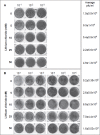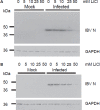Lithium chloride inhibits the coronavirus infectious bronchitis virus in cell culture
- PMID: 17479370
- PMCID: PMC7154305
- DOI: 10.1080/03079450601156083
Lithium chloride inhibits the coronavirus infectious bronchitis virus in cell culture
Abstract
The avian coronavirus infectious bronchitis virus (IBV) is a major economic pathogen of domestic poultry that, despite vaccination, causes mortality and significant losses in production. During replication of the RNA genome there is a high frequency of mutation and recombination, which has given rise to many strains of IBV and results in the potential for new and emerging strains. Currently the live-attenuated vaccine gives poor cross-strain immunity. Effective antiviral agents may therefore be advantageous in the treatment of IBV. Lithium chloride (LiCl) is a potent inhibitor of the DNA virus herpes simplex virus but not RNA viruses. The effect of LiCl on the replication of IBV was examined in cell culture using two model cell types; Vero cells, an African Green monkey kidney-derived epithelial cell line; and DF-1 cells, an immortalized chicken embryo fibroblast cell line. When treated with a range of LiCl concentrations, IBV RNA and protein levels and viral progeny production were reduced in a dose-dependent manner in both cell types, and the data indicated that inhibition was a cellular rather than a virucidal effect. Host cell protein synthesis still took place in LiCl-treated cells and the level of a standard cellular housekeeping protein remained unchanged, indicating that the effect of LiCl was specifically against IBV.
Le coronavirus de la bronchite infectieuse aviaire (IBV) est un agent pathogène économique majeur pour l'industrie avicole qui, malgré la vaccination, entraîne de la mortalité et des pertes importantes en production. Lors de la réplication de l'ARN génomique, il y a une fréquence élevée de mutations et de recombinaisons qui ont donné naissance à de nombreuses souches d'IBV et qui rend possible l'émergence de nouvelles souches. Actuellement les vaccins vivants atténués confèrent une immunité croisée faible entre souches. Les agents antiviraux efficaces peuvent alors être avantageux dans le traitement de l'IBV. Le chlorure de lithium (LiCl) est un inhibiteur puissant de l'herpesvirus simplex, virus à ADN, mais pas des virus à ARN. L'effet du LiCl sur la réplication de l'IBV a été examiné en culture cellulaire en utilisant deux modèles de type cellulaire, les cellules Vero, une lignée cellulaire épithéliale dérivée de rein de singe vert africain, et des cellules DF-1, une lignée cellulaire immortalisée de fibroblastes d'embryon de poulet. Lors du traitement avec différentes concentrations de LiCl, l'ARN de l'IBV, le taux de protéines et la production de virus ont été diminués de façon dose-dépendante pour les deux types de cellule et les données ont montré que l'inhibition était un effet cellulaire plutôt qu'un effet virucide. La synthèse des protéines de la cellule hôte avait toujours bien lieu dans les cellules traitées au LiCl et le niveau d'une protéine “de ménage” utilisée comme témoin d'expression cellulaire est resté inchangé, indiquant que l'effet du LiCl était spécifiquement dirigé contre l'IBV.
Das aviäre Coronavirus infektiöse Bronchitis Virus (IBV) ist ein ökonomisch bedeutsamer Krankheitserreger für das Wirtschaftsgeflügel, der trotz Vakzination Mortalität und Produktionseinbußen verursacht. Während der Replikation des RNS-Genoms kommt es häufig zu Mutationen und Rekombinationen, die eine Vielzahl von IBV-Stämmen entstehen ließen und die ein Potential für neu entstehende Stämme sind. Die gegenwärtig eingesetzten Lebendvakzinen geben gegen diese neuen Stämme nur eine geringe Kreuzimmunität. Aus diesem Grund wären wirksame antivirale Agentien von großem Vorteil für die Bekämpfung des IBV. Lithiumchlorid (LiCl) ist ein potenter Inhibitor des DNS-Virus Herpes simplex-Virus, aber nicht von RNS-Viren. Der Effekt von LiCl auf die IBV-Replikation wurde in der Zellkultur unter Verwendung von zwei Zelltypvarianten untersucht: Verozellen, eine von der Niere einer afrikanischen Grünen Meerkatze abstammenden Epithelzelllinie, sowie DF-1-Zellen, eine immortalisierte Hühnerembryofibroblastenzelllinie. Durch die Behandlung mit verschiedenen LiCl-Konzentrationen wurden die IBV-RNS und —Proteingehalte und die Virusvermehrung in beiden Zelltypen dosisabhängig reduziert. Die Ergebnisse zeigten, dass die Inhibition eher ein zellulärer als eine viruzider Effekt war. Die Proteinsynthese in der Wirtszelle fand in den LiCl-behandelten Zellen weiter statt und der Gehalt eines zellulären Standard-Organisationsproteins blieb unverändert, was darauf hin weist, dass der Effekt des LiCl spezifisch gegen das IBV gerichtet ist.
El coronavirus aviar de la bronquitis infecciosa (IBV) es uno de los patógenos con mayor impacto económico en avicultura, el cual, pese a la vacunación, causa mortalidad y pérdidas económicas significativas en la producción. Durante la replicación del genoma RNA se produce una gran frecuencia de mutación y recombinación que da lugar a una gran variedad de cepas de IBV e implica un potencial para la generación de cepas nuevas y emergentes. Actualmente las vacunas vivas atenuadas producen una inmunidad cruzada pobre. Por lo tanto, moléculas antivíricas efectivas podrían ser ventajosas en el tratamiento de IBV. El cloruro de litio (LiCl) es un potente inhibidor del virus herpes simple DNA pero no de virus RNA. Se estudió el efecto del LiCl en la replicación de IBV en dos tipos de cultivos celulares: células Vero, una línea celular epitelial derivada de riñón de mono Verde Africano, y células DF-1, una línea celular de fibroblastos de pollo inmortalizados. Cuando se trataron con un rango de concentraciones de LiCl, los niveles de proteínas y RNA de IBV y la producción de progenie se redujeron de manera dosis-dependiente en ambos tipos celulares, y los datos indicaron que la fue una inhibición más de tipo celular que un efecto viricida. La síntesis de proteínas celulares todavía tuvo lugar en las células tratadas con LiCl y el nivel de una proteína constitutiva estándar se mantuvo, indicando que el efecto del LiCl era específico frente a IBV.
Figures





Similar articles
-
Lithium chloride inhibits infectious bronchitis virus-induced apoptosis and inflammation.Microb Pathog. 2022 Jan;162:105352. doi: 10.1016/j.micpath.2021.105352. Epub 2021 Dec 7. Microb Pathog. 2022. PMID: 34883226 Free PMC article.
-
Comparative analysis of the effect of glycyrrhizin diammonium and lithium chloride on infectious bronchitis virus infection in vitro.Avian Pathol. 2009 Jun;38(3):215-21. doi: 10.1080/03079450902912184. Avian Pathol. 2009. PMID: 19468938
-
Inhibitory effects of lithium chloride on replication of type II porcine reproductive and respiratory syndrome virus in vitro.Antivir Ther. 2015;20(6):565-72. doi: 10.3851/IMP2924. Epub 2015 Jan 5. Antivir Ther. 2015. PMID: 25560301
-
Avian infectious bronchitis virus.Rev Sci Tech. 2000 Aug;19(2):493-508. doi: 10.20506/rst.19.2.1228. Rev Sci Tech. 2000. PMID: 10935276 Review.
-
Infectious Bronchitis Virus Evolution, Diagnosis and Control.Vet Sci. 2020 Jun 22;7(2):79. doi: 10.3390/vetsci7020079. Vet Sci. 2020. PMID: 32580381 Free PMC article. Review.
Cited by
-
Supplementing the feeds of layer pullets, at different ages with two different fiber sources improves immune function.Poult Sci. 2017 Aug 1;96(8):2718-2727. doi: 10.3382/ps/pex051. Poult Sci. 2017. PMID: 28371891 Free PMC article.
-
Lithium and Therapeutic Targeting of GSK-3.Cells. 2021 Jan 28;10(2):255. doi: 10.3390/cells10020255. Cells. 2021. PMID: 33525562 Free PMC article. Review.
-
Does Lithium Deserve a Place in the Treatment Against COVID-19? A Preliminary Observational Study in Six Patients, Case Report.Front Pharmacol. 2020 Aug 27;11:557629. doi: 10.3389/fphar.2020.557629. eCollection 2020. Front Pharmacol. 2020. PMID: 32973537 Free PMC article.
-
Efficacy and Safety of Lithium Treatment in SARS-CoV-2 Infected Patients.Front Pharmacol. 2022 Apr 14;13:850583. doi: 10.3389/fphar.2022.850583. eCollection 2022. Front Pharmacol. 2022. PMID: 35496309 Free PMC article.
-
Antiviral effect of lithium chloride on infection of cells by porcine parvovirus.Arch Virol. 2015 Apr;160(4):1015-20. doi: 10.1007/s00705-015-2352-z. Epub 2015 Feb 8. Arch Virol. 2015. PMID: 25663217 Free PMC article.
References
-
- Adzhar A., Shaw K., Britton P. & Cavanagh D. (1996). Universal oligonucleotides for the detection of infectious bronchitis virus by the polymerase chain reaction. Avian Pathology, 25, 817–836. - PubMed
-
- Bicknell K.A., Brooks G., Kaiser P., Chen H., Dove B.K. & Hiscox J.A. (2005). Nucleolin is regulated both at the level of transcription and translation. Biochemical and Biophysical Research Communications, 332, 817–822. - PubMed
-
- Bochkov Y.A., Batchenko G.V., Shcherbakova L.O., Borisov A.V.L. & Drygin V.V. (2006). Molecular epizootiology of avian infectious bronchitis in Russia. Avian Pathology, 35, 379–393. - PubMed
Publication types
MeSH terms
Substances
LinkOut - more resources
Full Text Sources
Miscellaneous
